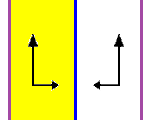Top Qs
Timeline
Chat
Perspective
Infinite dihedral group
Type of mathematical group From Wikipedia, the free encyclopedia
Remove ads
In mathematics, the infinite dihedral group Dih∞ is an infinite group with properties analogous to those of the finite dihedral groups.
This article needs additional citations for verification. (July 2011) |

In two-dimensional geometry, the infinite dihedral group represents the frieze group symmetry, p1m1, seen as an infinite set of parallel reflections along an axis.
Remove ads
Definition
Summarize
Perspective
Every dihedral group is generated by a rotation r and a reflection s; if the rotation is a rational multiple of a full rotation, then there is some integer n such that rn is the identity, and we have a finite dihedral group of order 2n. If the rotation is not a rational multiple of a full rotation, then there is no such n and the resulting group has infinitely many elements and is called Dih∞. It has presentations
and is isomorphic to a semidirect product of Z and Z/2, and to the free product Z/2 * Z/2. It is the automorphism group of the graph consisting of a path infinite to both sides. Correspondingly, it is the isometry group of Z (see also symmetry groups in one dimension), the group of permutations α: Z → Z satisfying |i − j| = |α(i) − α(j)|, for all i, j in Z.[2]
The infinite dihedral group can also be defined as the holomorph of the infinite cyclic group.
Remove ads
Aliasing
Summarize
Perspective

An example of infinite dihedral symmetry is in aliasing of real-valued signals.
When sampling a function at frequency fs (intervals 1/fs), the following functions yield identical sets of samples: {sin(2π( f + Nfs) t + φ), N = 0, ±1, ±2, ±3, . . . }. Thus, the detected value of frequency f is periodic, which gives the translation element r = fs. The functions and their frequencies are said to be aliases of each other. Noting the trigonometric identity:
we can write all the alias frequencies as positive values: . This gives the reflection (f) element, namely f ↦ −f. For example, with f = 0.6fs and N = −1, f + Nfs = −0.4fs reflects to 0.4fs, resulting in the two left-most black dots in the figure.[note 1] The other two dots correspond to N = −2 and N = 1. As the figure depicts, there are reflection symmetries, at 0.5fs, fs, 1.5fs, etc. Formally, the quotient under aliasing is the orbifold [0, 0.5fs], with a Z/2 action at the endpoints (the orbifold points), corresponding to reflection.
Remove ads
See also
- The orthogonal group O(2), another infinite generalization of the finite dihedral groups
- The affine symmetric group, a family of groups including the infinite dihedral group
Notes
- In signal processing, the symmetry about axis fs/2 is known as folding, and the axis is known as the folding frequency.
References
Wikiwand - on
Seamless Wikipedia browsing. On steroids.
Remove ads






![{\displaystyle \sin(2\pi (f+Nf_{s})t+\varphi )={\begin{cases}+\sin(2\pi (f+Nf_{s})t+\varphi ),&f+Nf_{s}\geq 0,\\[4pt]-\sin(2\pi |f+Nf_{s}|t-\varphi ),&f+Nf_{s}<0,\end{cases}}}](http://wikimedia.org/api/rest_v1/media/math/render/svg/542c698d95b2071bb34f356c4b5e5e846cfcb3e7)
